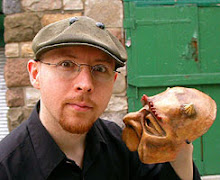QUEST: The Best Paper Mache.
PROPERTIES
•Durable
•Strong against impact
•Strong against pressure (crushing)
•Strong against scratches
•Lightweight
•Smoothness when needed
•Easy to apply
•Definition (accuracy in details, with or without using a mold)
•Stable in temperature changes (not brittle when cold, not saggy when hot)
•Dries matte
•Economical
•Non Toxic
My Definition of The Best Paper Pache:
A paper, a glue (or adhesive), a sealer and some textural and colored finishes combined to create an accurate, durable and lightweight piece of art that is strong enough to be a performance object.
Ideally, the best Paper Mache would be made with natural ingredients only, in order to be healthier, and not dependent on a highly specialized industry. So it could be made in most any situation, independent on the economical or commercial availabilities.
In my personal endeavours, acrylic paint remains the most practical paint to use (fast drying, readily available). I have hopes to make it work on top of my natural paper mache approach, but also need to find a completely natural paint that will be just as water resistant, or better. Oil Paint is the best contender so far.
Best papers I've tried:
•coffee filters (thin yet very strong, applies smoothly, edges disappear like magic)
•Kraft paper (various thicknesses, great for quickly building thickness and strength
•Paper Towels (used as a smooth or textured finish)
These three papers are the best for my purposes. Your purposes may have you require other papers.
Best Glues/ adhesives I've tried
•Wheat Paste (current favorite).
It has all the properties I need for the best paper mache, except I have not found an appropriate sealer that will be compatible with it, and acrylic paints.
•Weldbond
It is a higher quality than any other PVA adhesive I tried. It dries clear, is flexible, acid free, and scratch resistant. It also resist water better than other PVA. It is also ideal as a basecoat for acrylic paint, which never seems to separate from it (other PVA make acrylic paint crack, which is a great effect only when one wants and controls it). I use it as a sealer for my pva-glue paper mache projects, it is a great basecoat for acrylic paint, contrary to all other PVA glues I tried. Added to joint compound and water, it makes Monster Bone, which is what I finish all my paper mache project with, for an infinity of textural possibilities. Added to the paint, it makes it scratch resistant, but add a bit of gloss.
Not great for building stable hollow structures, because it is too flexible, but that flex makes it ideal to cover or repair flexible materials.
•PVA glues (aka white glue: Elmer's, Lepage, Mastercraft, etc)
They all work well, except for the major instability under temperature changes. They are brittle when cold, and saggy when hot. Still usable in most situations, but that extra worry must be eliminated.
Already Amazing, but not enough.
I already have methods that work incredibly well.
After all, I can throw my paper mache puppets or masks against a wall or floor, and they will bounce back unharmed, save a few occasional scratches, depending on surfaces.
You can get most of my methods for free, on this very site, if you search a bit.
I just realized I don't have an updated article about my best methods. I shall write one soon as I have time.
In the meantime, my favorites:
These results are just not strong enough for me, because of the heat/cold instability.
They are nearly indestructible in comfortable room temperature, but become temporarily brittle in the cold, or can be warped by pressure if it gets too hot. Which is why I switched to Wheat Paste, which doesn't seem to have this issue at all. The problem is finding a sealer that will protect it from moisture, and still allow for painting with acrylics. Also, if paints made with natural products have been proven to work for a durable, water-resistant finish over paper mache, maybe with a varnish compatible with them, I'd love to know!
We Need Everyone's help
Information that is easily accessible to some, is not made available to most.
Hundreds of years of paper mache tradition, from various countries, and the techniques are not fully accessible online, in the "age of information".
I'm calling upon all Artists, Crafters, and Workers of paper mache, to check their own information and that of the people they know, to see if it is well known by all. What may seem obvious to you can often be a wonderful discovery and time saver for everyone else. If it is not well known, please make it available, by sharing it here and on the paper mache websites, such as PaperMacheArt and Paper Mache UK.
Send me your information at creaturiste @ gmail.com
What information would help us all tremendously:
•Fully Described Traditional Methods from China, Japan, Mexico, Philippines, Germany, Russia, Italy...
because these countries seem to be the major experts, historically.
Questions to be answered by professionals:
•What is your favorite, time-tested natural paper mache approach?
•Best sealer for each paper mache+adhesive types (wheat paste, pva, acrylic medium)
•Best paints (preferably natural)
•Best Varnishes for specific paints (preferably natural or water based)
•What is best: dipping strips or applying glue with a brush?
Upcoming tests:
•Sealing with household "latex" paint (which is not really a natural product, so not a truly ideal solution, but still a good viable one).
•Sealing with Acrylic Gesso (which has always weakened my PVA-based paper mache projects in the past, maybe it won't do that to wheat-based?)
Thanks for your input. Together we can come up with the answers.
I'd like to compile them into one simple tutorial document, and publish it online for all to see.




